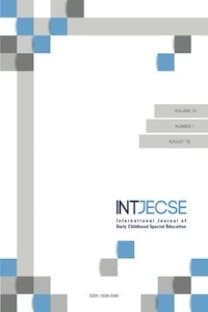Transforming Transdisciplinary Early Intervention and Early Childhood Special Education through Intercultural Education
Intercultural education, transdisciplinary teaming; early intervention; early childhood special education
___
Abdallah-Pretceille, M. (1990). Vers une pedagogie interculturelle. Paris, FR: INRP Sorbonne.Abrams, M., Matthey, J., Murrer, B., Bernardo, F., & Shehan, C. (2000) (Eds.). Through the eyes of the child: Re-visioning children as active agents of family life. Bingley, UK: Emerald.
Aldridge, J., Kilgo, J., & Christensen, L. (in press). Turning culture upside down: The role of Transcultural education. Social Studies Research and Practice.
Bennett, M. (1993). Toward ethnorelativism: A developmental model of intercultural sensitivity. In R. Pagie (Ed.), Education for the intercultural experience (pp. 21-71). Yarmouth, ME: Intercultural Press.
Blair, S. (2012) (Ed.). Economic stress and the family. Bingley, UK: Emerald.
Claster, S., & Blair, S. (2013). Visions of the 21st century family: Transforming structures and identities. Bingley, UK: Emerald.
Clifford, V. (2011). Moving from multicultural to intercultural education in Australian Higher Education. In C. Grant & A. Portera (Eds.), Intercultural and multicultural education: Enhancing global interconnectedness (pp. 315-323). New York, NY: Routledge.
Collins, J. (1988). Language and class in minority education. Anthropology and Education Quarterly, 19(4), 299-326.
Cooper, P. (1996). Are Individual Education Plans a waste of paper? British Journal of Special Education, 23(3), 115-119.
Daly, K. (2001) (Ed.). Minding the time in family experience: Emerging perspectives and issues. Bingley, UK: Emerald.
Dessel, A., Rogge, M., & Garlington, S. (2006). Using intergroup dialogue to promote social justice and change. Social Work, 51(4), 303-315.
DeTurk, S. (2006). The power of dialogue: Consequences of intergroup dialogue and their implications for agency and alliance building. Communication Quarterly, 54(1), 33-51.
Division of Early Childhood. (2014). DEC recommended practices in early intervention/early childhood special education. Retrieved from http://www.dec-sped.org/recommendedpractices
Fox, G., & Benson, M. (2000) (Eds.). Families, crime and criminal justice: Charting thelinkages. Bingley, UK: Emerald.
Garcia, S. (2012). The preservice classroom as an intercultural space for experiencing a process of cultural reciprocity. In M. Kalyanpur & B. Harry (Eds.), Cultural reciprocity in special education: Building family-professional relationships (pp. 155-174). Baltimore, MD: Paul H. Brookes.
Gargiulo, R., & Kilgo, J. (2014). An introduction to young children with special needs: Birth through age eight (4th ed.). Belmont, CA: Wadsworth/Cengage Learning.
Gorski, P. (2006). Complicity with conservatism: The de-politicizing of multicultural and intercultural education. Intercultural Education, 17(2), 163-177.
Gorski, P. (2008). Good intentions are not enough: A decolonizing intercultural education. Intercultural Education, 19(6), 515-525.
Gorski, P. & Landsman, J. (2014) (Eds.) The poverty and education reader: A call for equity in many voices. Sterling, VA: Stylus.
Grant, C., & Brueck, S. (2011). A global invitation: Toward the expansion of dialogue,reflection and creative engagement for intercultural and multicultural education. In C. Grant & A. Portera (Eds.), Intercultural and multicultural education: Enhancing global interconnectedness (pp. 3-11). New York, NY: Routledge.
Gudykunst, W., & Kim, Y. (2003). Communicating with strangers: An approach to Intercultural communication (4th ed.). Boston, MA: McGraw-Hill.
Gundara, J. (2011). Citizenship and intercultural education in an international andcomparative context. In C. Grant & A. Portera (Eds.), Intercultural and multicultural education: Enhancing global interconnectedness (pp. 294-314). New York, NY: Routledge.
Jones, A. (1999). The limits of cross-cultural dialogue: Pedagogy, desire, and absolution in the classroom. Educational Theory, 49(3), 299-316.
Kilgo, J. (2006) (Ed.). Transdisciplinary teaming in early intervention/early childhoodspecial education. Olney, MD: Association for Childhood Education International.
Kilgo, J., & Aldridge, J. (2013). A team-based approach to sustain collaboration with Families Representing diverse cultural backgrounds. Paper presented at the Division for Early Childhood (DEC) 29th Annual International Conference on Young Children with Special Needs and Their Families, San Francisco, CA, October 17, 2013.
Lasonen, J. (2011). Multiculturalism in the Nordic countries. In C. Grant & A. Portera (Eds.), Intercultural and multicultural education: Enhancing global interconnectedness (pp. 261-278).
Lynch, E., & Hanson, M. (2011). Developing cross-cultural competence: A guide for working with children and their families (4th ed.). Baltimore, MD: Paul H. Brookes.
Marginson, S., & Sawir, E. (2011). Ideas for intercultural education. New York, NY:Palgrave Macmillan.
McWilliam, R. (2010). (Ed.) Working with families of young children with special needs. New York, NY: The Guilford Press.
Miller, M., & Petriwskyj, A. (2013). New directions in intercultural early education in Australia. International Journal of Early Childhood, 45(2), 251-266.
Olson, C., & Kroeger, K. (2001). Global competency and intercultural sensitivity.Journal of Studies in International Education, 5(2), 116-37.
Pillemer, K., & Luscher, K. (2003) (Eds.). Intergenerational ambivalences: New perspectives on parent-child relations in later life. Bingley, UK: Emerald.
Portera, A. (2011). Intercultural and multicultural education: Epistemological and semantic aspects. In C. Grant & A. Portera (Eds.), Intercultural and multicultural education: Enhancing global interconnectedness (pp. 12-30). New York, NY:
Routledge.
Robila, M. (2004) (Ed.). Families in Eastern Europe. Bingley, UK: Emerald.
Shields, C., Bishop, R., & Mazawi, A. (2005). Pathologizing practices: The impact of deficit thinking on education. New York, NY: Peter Lang.
Spencer, H. (1884). What knowledge is of most worth? New York, NY: John B. Alden.
Turnbull, H., Huerta, N., & Stowe, M. (2004). The Individuals with Disabilities Education Act as amended in 2004. Upper Saddle River, NJ: Pearson Education.
- ISSN: 1308-5581
- Başlangıç: 2009
- Yayıncı: İbrahim H. DİKEN
Ayşe Tuba Ceyhun, Selda ÖZDEMİR, Gökhan TÖRET, Ufuk Özkubat
Exploring Efficacy of a Community-Based Reading Programme for At-Risk ChildrenJanet Siew Poh LAW
Janet Siew Poh LAW, Noel Kok Hwee CHIA
Serhat Odluyurt, Hatice Deniz DEGİRMENCİ, Iclal Adalioglu, Alper Kapan
Jerry Aldridge, Jennifer L. Kilgo, A.k. Bruton BRUTON
Meram Mısır HORASAN, Binyamin Birkan
Cem Aslan, Selda ÖZDEMİR, Pinar DEMİRYUREK, Hale COTUK
Special Educational Needs and Support Provisions in Swedish Preschools: A Multiple-Case Study
